Re-roofing your home is a major investment. It’s important to understand how the process works, so you can make an informed decision about the materials and services you want to include in your project.
Roofers must remove the existing shingles before installing new ones. Adding a steel or metal roof over an old shingle roof is possible but can cause sagging of the rafters over time. Contact Glacier Roofing for professional assistance.
Whether working as a roofing contractor or doing roof repairs at home, safety should be top of mind for everyone involved in roofing work. From ensuring that safety protocols are followed to keeping workers hydrated and protected, homeowners and contractors alike need to be mindful of the risks associated with roofing installation.
The first step to a safe work environment is conducting a pre-work inspection and hazard assessment. This helps identify structural weaknesses, existing hazards, and weather conditions that may impact the roof installation process. This information should be documented and compiled to create a framework for the project’s risk management plan.
Another important step to take is training workers on the proper use and care of personal protective equipment (PPE). Choosing the right helmets, shoes with traction, safety harnesses, and other gear can significantly reduce accidents and injuries during roofing. It’s also crucial to inspect PPE regularly and keep it free of debris or materials that could hinder workers’ movements on the roof.
In addition to ensuring that safety protocols are followed, it’s essential for teams to be able to communicate effectively on the job site. Standardized communication channels, such as real-time messaging apps or specialized roofing software, allow employees to share important updates in an emergency and provide timely assistance if needed.
Finally, it’s crucial to have a clear process for reporting hazards on the job. This includes developing a positive reporting culture where workers feel comfortable coming forward with concerns about their safety. This can be achieved by providing training on how to report a hazard, setting up a clear reporting system, and providing incentives for workers who come forward with safety concerns.
Performing roof work exposes workers to many dangers, including falls, tool-related injuries, and electrocution. These risks can be mitigated by following the Occupational Safety and Health Administration’s guidelines, which require that workers use fall protection systems when they’re working more than 6 feet above a lower level. These systems include safety nets or lanyards with lifelines and anchor points that prevent falls, one of the most common causes of workplace injuries.
Materials
Roofing materials help define the look and feel of a home. They also provide important benefits like longevity, air quality, extra structural support and climate compatibility. There are a number of different materials to choose from and it is important to consider the cost, life span and warranty when choosing the right roof for your home.
Asphalt shingles are the most popular residential roofing material in the United States and offer an economical option with a long life span. They are available in a wide range of styles and colors to complement any home and come with a variety of warranties. They perform well in wet climates, are fire-resistant and have good durability.
Wood shingles and shakes are an attractive roofing option, especially on older homes and those with Craftsman or Cape Cod cottage style. They are crafted from cedar or redwood and can be stained any color. While they are durable and aesthetically pleasing, they do not perform well in damp climates, require regular maintenance, and can be susceptible to damage from wildfire.
Composite shakes and slate offer the beauty of authentic materials without the additional maintenance. Made from a combination of plastic, wood and asphalt, these roofs are resistant to rot and decay and are designed to last for years.
Tile roofs add texture and elegance to a home. They are available in a number of styles and colors, and can work well with Mediterranean, Mission or Southwestern-style homes. They are durable and energy efficient, but they can be expensive to install and require specialized framing.
Rolled roofing is a budget-friendly option for low-slope residential roofs and outbuildings such as sheds and garages. It is comprised of long rolls of mineral-impregnated and asphalt-impregnated tar-and-gravel material topped with mineral granules. It is typically secured with a torch-down method or nails and lasts for about 10 to 15 years.
Solar shingles are one of the newest types of roofing, offering the added benefit of harnessing solar energy to power your home. They are a great choice for homeowners who want to reduce their energy bills and help the environment.
Preparation
A quality roof installation requires thorough preparation of the roof deck. This includes a thorough cleaning to remove any dirt, grease, contaminants, tools or other debris that could interfere with the coating adhesion. The surface should also be free of loose shingles and other materials. In addition, any damaged or rotten sections of the deck should be repaired before attempting to re-coat the surface.
If you are re-roofing and have underground wires in the attic, you will need to have them moved or covered by a licensed electrician prior to beginning your new roof installation. These wires can be a fire hazard if fasteners penetrate the insulation and cause a short circuit. Likewise, any exposed electrical wiring in the attic must be covered with foil backed insulation, or covered with a heavy-duty vapor barrier.
It is a good idea to move your outdoor furniture, grills, lawn ornaments, kids’ toys, or other items away from the house during the roofing process. This will prevent them from being knocked over or damaged by falling shingles and other debris.
The roofers will need to walk all the way around your home, so it’s important to have at least 15-foot clearance in all directions. This will allow them to safely access the work area without tripping over your lawn furniture or decorations.
Before starting your roof installation, the crew will inspect your existing flashing and drip edges to determine if they are in good condition or need to be replaced. If they are in good shape, the crew will probably simply use them as a base for your new roofing materials.
During your roofing installation, you can expect to hear loud noises such as the pounding of hammers and nail guns. This can make pets, especially dogs, nervous and anxious. For this reason, it is a good idea to have them stay with friends or family during the process. Keeping them inside will also help you prevent a mess on your floors, and they will be more comfortable away from the unfamiliar noises. Alternatively, you may wish to consider doggie day care or a pet hotel for the duration of your roofing project.
Installation
Roofing installation is performed by professional roofing contractors who have the knowledge and skills to ensure that the roof will protect and defend the structure from rain, snow, sun, and hail. They can install a variety of roofing materials including asphalt shingles, metal sheeting, tile, wood shakes, and more. These professionals will help the homeowner decide on a roofing material that suits their aesthetic preferences and budget. They will also explain the strengths and limitations of each type of roof.
The roofers will start by inspecting the existing roof and determining its condition. They will look for any areas that need repair or replacement. They will also determine whether the roof is suitable for a like-in-kind roof or if re-roofing is required.
Once the crew has determined the plan, they will prepare for the project. They will cover any surrounding plants with tarps and/or wooden boards to prevent debris from falling onto them. They will also place a roll-off dumpster at the curb or in the driveway for easy disposal of old shingles. They will then set up their tools, generators, and everything else needed to begin the job. They will also cover any attic vents and/or crawl spaces to keep them clean and protected during the installation process.

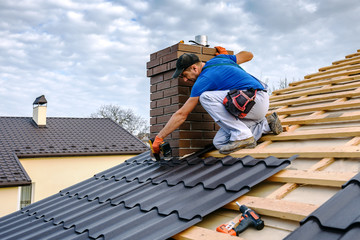
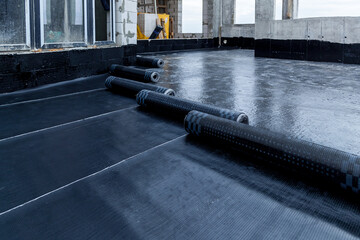
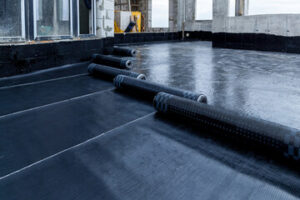
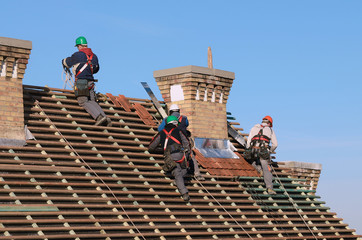
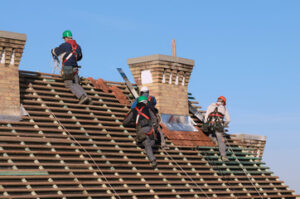 If you notice a steady gush of water on your ceiling, you may be in for some real damage. Your walls and floor will most likely become damp and drafty; the best way to avoid this is to limit the damage. Getting an expert eye on your roof periodically can help. You can also purchase extra shingles to do the job of replacing broken ones a lot easier.
If you notice a steady gush of water on your ceiling, you may be in for some real damage. Your walls and floor will most likely become damp and drafty; the best way to avoid this is to limit the damage. Getting an expert eye on your roof periodically can help. You can also purchase extra shingles to do the job of replacing broken ones a lot easier.